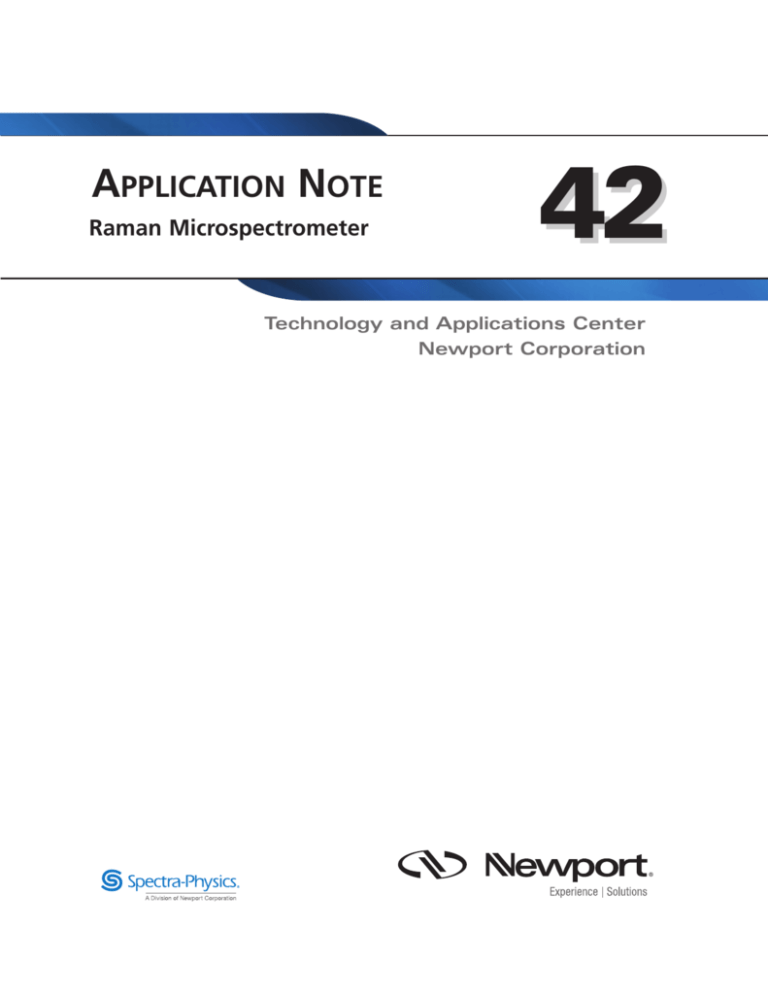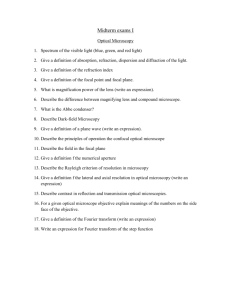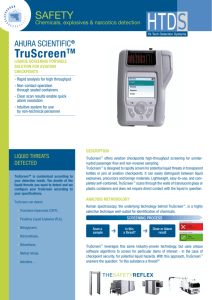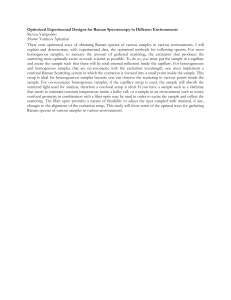
APPLICATION NOTE
Raman Microspectrometer
42
Technology and Applications Center
Newport Corporation
Introduction:
Raman scattering was discovered by Sir C. V. Raman1,2 in the
1920’s. Since then Raman spectroscopy has become one of
the most popular analytical techniques. It provides
comprehensive information about the vibrational modes of
molecules by monitoring macroscopic light scattering and has
created an entire new branch of molecular spectroscopy. The
Raman scattered light from the molecules, frequency shifted
relative to the frequency of the light source, is generally
polarized and contains information about the vibrational
frequencies and anisotropy of molecular vibrations. As is well
known, vibrational modes are like fingerprints of molecules.
Therefore, Raman scattering is endowed with the sensitivity
to discern different molecular species. Raman spectroscopy
has broad applications, ranging from fundamental physical
chemistry, inorganic chemistry, biochemistry, art and
archaeology, to highly practical forensic examinations3.
Unlike Rayleigh scattering, where the scattered light has the
same frequency and strong signal relative to the excitation,
Raman scattering is frequency shifted and extremely weak
(about one photon out of 109 ~ 1011 impinging photons is
scattered). As Raman himself pointed out, “the chief difficulty
which had oppressed us in the study of the new phenomenon
(Raman scattering) was its extreme feebleness in general”4;
increasing the sensitivity, resolution and ease of use of the
experimental setups are of prime interest. After the first
experiments done by Raman, significant advances over the
years in light sources (monochromic laser sources vs.
sunlight), filters (varieties of dichroic filters vs. glass filters)
and detectors (CCD cameras, etc. vs. photographic films)
boosted the feasibility and popularity of this technique. It is
important to point out that the resolution of the Raman
scattering is determined by the bandwidth of the light source
and the resolution of the spectrometer, while the sensitivity
threshold is mainly defined by the optics and detectors being
employed.
Another technique related to vibrational spectroscopy, Fourier
Transformed Infrared Spectroscopy (FTIR), is often compared
with Raman scattering. In fact, the two techniques
complement each other. Approximately, a vibrational mode
would be infrared active if the vibration causes the
change of the molecule’s dipole moment. On the other hand,
it would be Raman active if the vibration induces the change
of the molecule’s polarizability5. Experimentally, Raman
spectroscopy is favored by researchers because the
components for the spectrometer are readily available and the
entire setup can be situated in open air. On the contrary, a
FTIR spectrometer includes a wide radiation spectrum lamp,
purging system, motorized translation stages, temperature
controlled semiconductor detectors (TE cooled InGaAs
detector for instance) and a mathematical algorithm to
deconvolve the interferogram. It is therefore not cost efficient
and discourages researchers from building it from the bottom
up. Consequently, commercial FTIR systems are frequently
2
shared by researchers. One concern with Raman scattering
that must be controlled is the potential background
fluorescence from the samples while FTIR has interferences
from water vapor and CO2 that must be removed via purge or
background subtraction.
In this application note, we present the theory of Raman
scattering, describe a simple and easy-to-implement
experimental Raman setup, and show the results on several
liquids and some organic compounds to exemplify the
sensitivity and resolution of the system.
Theory
A classical treatment is presented here to elucidate
the essential phenomena of Raman scattering5. To begin
~
with, notice that the scattered field ES(t) originates from the
~
induced oscillatory polarization PS(t) of the sample after the
~
interaction with the input field, Ei (t). It can be expressed as:
;(1)
where is the polarizability tensor of the molecule, and X, Y,
Z is the lab reference coordinate system. is a function of
electron clouds and nuclei of the molecule and is influenced
by the molecular vibrations. Considering a vibrational mode
specified by the normal coordinate, Qk, can be expanded as:
+ higher order terms;
(2)
Equation (2) shows that the displacement of the vibration
directly influences the polarizability. In addition, the vibration
of a mode and the input field can be expressed as:
(3)
In equation (3), k is the vibrational frequency and is the
frequency of the light source. Substituting (3) and (2) into (1),
we arrive at:
(4)
Using the trigonometric identity,
, part (b) in equation (4)
can be expressed:
;
(5)
According to (a) of (4), part of the scattered light has the same
frequency as the light source and is referred to as Rayleigh
scattering. On the other hand, (b) contains the frequencies
ofww+w k and - k and are called anti-Stokes Raman and
Stokes Raman scattering, respectively. Therefore, by
measuring the frequencies of the scattered light, we would be
able to infer the frequencies of the molecular vibrational
modes. From (2) we can also see that under the first order
approximation, the vibration would be Raman active if the
derivative of the polarizability is not zero.
Experimental Setup
spectrometer. The condenser lens on the linear stage focuses
it on the entrance slit of the spectrometer. After the alignment
procedure, the sample of interest is put on the sample holder.
At this point, only small adjustments of the objective/lens,
condenser lens, and the last mirror before the condenser lens
would be required to maximize the Raman signal.
In the setup we described above, Stokes Raman scattering is
measured. By simply modifying the system to use different
kinds of filters, the measurements of the anti-Stokes Raman
Scattering can also be achieved.
Figures
The setup is based on a 532 nm CW single frequency DPSS
laser (Excelsior®, Spectra-Physics) as the light source. Lasers
with longer wavelengths are more preferable in Raman
experiments since some of the fluorescence can be avoided.
For example, Newport’s 785nm Raman Laser Module, would
be an appropriate choice. Figure 1 shows the homebuilt
Raman microspectrometer system used in Newport’s
Technology & Application Center (TAC). The laser beam
passes through a variable attenuator (application note 26)
used to control the laser intensity. Then the beam is routed
into a 45˚ dichroic beamsplitter. The beamsplitter has to be
set exactly at 45˚ to the incident beam in order to maximize
the reflection of the light source into the sample and
transmission of the Raman scattered signal, as well as
minimize the transmission of the back-reflected laser beam.
Without employing a microscope at this stage, the laser beam
can be focused by a simple lens into the sample situated on
XYZ stages. In the setup described in this application note,
the laser beam is routed into a microscope and then focused
in the sample by an objective. The sample is held on the XY
observation platform of the microscope and the focal point is
controlled by adjusting the height of the objective.
The scattered Raman light is collimated by the objective/lens
and all wavelengths longer than the light source are passed
through the same 45˚ dichroic beamsplitter. Most residual
source light is cut off at this point. After passing through this
filter, the beam is routed and focused on the entrance slit of a
spectrometer by a condenser lens. This lens is situated on a
stage in order to adjust the focal point of the Raman field
relative to the entrance slit. A zero degree long wave pass filter
is used in front of the entrance slit to block any residual
scattered excitation light. The spectrometer is composed of
a monochromator (MS260i™ 1/4m Spectrograph) and a CCD
camera (InstaSpec® X). The Raman field is dispersed by the
monochromator and imaged by the CCD camera.
The fluorescence from a rhodamine dye solution is used to
align the spectrometer. The objective/lens collimates the
fluorescence and fills the entire apertures of the filter and
subsequent routing mirrors. Three metallic mirrors after the
filter are used to route the fluorescence light into the
Figure 1. (a) A diagram shows the principle of the experimental setup. M: mirror,
W: waveplate, P: polarizer, S: sample, F1: 45˚ beamsplitter, F2: long wave pass filter,
L1: objective or lens, L2: condenser lens, ES: entrance slit of the spectrometer. The
dashed circle marks the attenuator. (b) Photograph of the Raman
Microspectrometer setup in the Newport TAC. The laser is shown in green, while
the Raman scattered field is shown in orange.
Results
Figure 2 shows the experimental results for several neat
solvents. In all of the experiments, the exposure time was less
than 20 seconds. In some cases, like with cyclohexane, the
measurement can actually be monitored in real time (the
3
Figure 2. Raman spectra of n-hexane (a), methanol (b), acetone (c), water (d), carbon tetrachloride (e), cyclohexane (f). The inset of
each spectrum shows the region where the peaks are most congested.
4
frame was updated every second and the result is
satisfactory). Even in the highly congested parts of the
spectra, such as fingerprint regions of hexane (inset of figure
2(a)) or C-H stretch regions of n-hexane, cyclohexane, and
acetone (figures 2(a), (c) and (f)), the spectra are well resolved.
By comparing the spectra, a resolution better than 3 cm-1 is
achieved. The flat baselines in figure 2 are an indication of
excellent signal-to-noise ratio. As shown in the low frequency
region of figure 2(d), this cutoff frequency occurs at about 180
cm-1, making the study of low vibrational modes feasible. The
presented results demonstrate the high sensitivity and
resolution of this simple setup.
In the next example, we recorded Raman spectra of ethyl
acrylate and ethyl propionate. The geometries of these
molecules are similar, however, ethyl acrylate has conjugated
double bonds (carbonyl and C-C double bond) while
propionate has only the carbonyl group. Figure 3(a) shows
their molecular structures for comparison. We dissolved both
chemicals in carbon tetrachloride and the results are shown in
figure 3(b). As can be seen from figure 3(b), the Raman spectra
of these two chemicals are very different despite their similar
molecular structures. The biggest discrepancy occurs in the
frequency region between 1600 and 1800 cm-1. This region
contains the vibrational modes that involve stretching of
double bonds. For ethyl acrylate, there are two vibrations (inphase and out-of-phase double bonds stretches, as shown on
the inset of figure 3(b)). For ethyl propionate, there is only one
vibration involving the stretch of the carbonyl group. In
addition, the Raman intensities of these modes of ethyl
acrylate are much stronger than that of ethyl propionate. Two
main reasons account for this. First of all, in a conjugated
system like ethyl acrylate, the electrons are delocalized
through π-bonds interaction. In other words, the electrons are
less trapped by the nuclei and easily polarized by the electric
field. As a result, the polarizability is larger. Secondly, the
deformation caused by the vibrational modes of acrylate is
larger than that of ethyl propionate since it involves two
double bonds. This induces a larger change of the
polarizability.
Figure 3. (a) The chemical structures of ethyl acrylate and ethyl propionate.
(b) The Raman spectra of ethyl acrylate and ethyl propionate in CCl4. Blue/red
traces are for ethyl acrylate/propionate solution, respectively. The spectra in the
1600 cm-1 region are shown in the inset where the dominant displacements of the
normal modes are also demonstrated.
Then, we recorded the Raman spectra of two monomers
frequently used in photo-polymerization processes
(application note 37). They are both triacrylate monomers and
named SR-499 and SR-368 (Sartomer Company, Inc., Exton,
PA). The molecular structure and the measured Raman
spectra are shown in figure 4. SR-499 has a vibrational mode
which is related to the carbonyl group and labeled as m, while
5
SR-368 has two of those modes,? and ?. These vibrations have
similar frequencies since the main displacements of these
modes involve the stretch of the carbonyl groups. Their
Raman spectra are shown in Figure 4(b). They are similar
except in the 1700 cm-1 frequency region. As shown in the inset
of Figure 4(b), two peaks related to the different carbonyl
groups of SR-368 are well resolved. Only one peak is observed
for SR-499. In addition,? and ?have almost the same
frequency. All of these results coincide perfectly with
predictions from the structures of the molecules.
Figure 4. (a) Molecular structures of SR-499 and SR-368. Also shown are the
carbonyl groups which contribute to different vibrational modes. (b) Raman spectra
of SR-499 and SR-368. Inset: the 1700 cm-1 region is magnified to show different
vibrational modes of the molecules.
Conclusion
A homemade Raman spectrometer is presented in this
application note. The system is compact, simple and costeffective. The performance is demonstrated using several
chemicals as examples. Excellent sensitivity and resolution
are achieved.
6
References
1. C.V. Raman, and K.S. Krishnan, A New Type of Secondary Radiation. Nature, (1928).
121: 501-502.
2. C.V. Raman, A New Radiation. Indian Journal of Physics, (1928). 2: 387.
3. E. Smith and G. Dent, Modern Raman Spectroscopy: A Practical Approach. (2005).
4. C.V. Raman, The Molecular Scattering of Light. Nobel Lecture, (1930).
5. D.A. Long, The Raman Effect: A Unified Treatment of the Theory of Raman Scattering by
Molecules. (2001).
7
Newport Corporation
Worldwide Headquarters
1791 Deere Avenue
Irvine, CA 92606
(In U.S.): 800-222-6440
Tel: 949-863-3144
Fax: 949-253-1680
Email: sales@newport.com
Visit Newport Online at: www.newport.com
This Application Note has been prepared based on development activities and experiments conducted in Newport’s Technology
and Applications Center and the results associated therewith. Actual results may vary based on laboratory environment and setup
conditions, the type and condition of actual components and instruments used and user skills.
Nothing contained in this Application Note shall constitute any representation or warranty by Newport, express or implied,
regarding the information contained herein or the products or software described herein. Any and all representations,
warranties and obligations of Newport with respect to its products and software shall be as set forth in Newport’s terms and
conditions of sale in effect at the time of sale or license of such products or software. Newport shall not be liable for any costs,
damages and expenses whatsoever (including, without limitation, incidental, special and consequential damages) resulting from
any use of or reliance on the information contained herein, whether based on warranty, contract, tort or any other legal theory, and
whether or not Newport has been advised of the possibility of such damages.
Newport does not guarantee the availability of any products or software and reserves the right to discontinue or modify its
products and software at any time. Users of the products or software described herein should refer to the User’s Manual and other
documentation accompanying such products or software at the time of sale or license for more detailed information regarding the
handling, operation and use of such products or software, including but not limited to important safety precautions.
This Application Note shall not be copied, reproduced, distributed or published, in whole or in part, without the prior written
consent of Newport Corporation.
Copyright ©2009 Newport Corporation. All Rights Reserved. Spectra-Physics®, the Spectra-Physics “S” logo, the Newport “N” logo,
Excelsior® and InstaSpec® are registered trademarks of Newport Corporation. Newport™ is a trademark of Newport Corporation.
Newport Corporation, Irvine, California, has
been certified compliant with ISO 9001 by
the British Standards Institution.
MM#9000102
DS-04093










